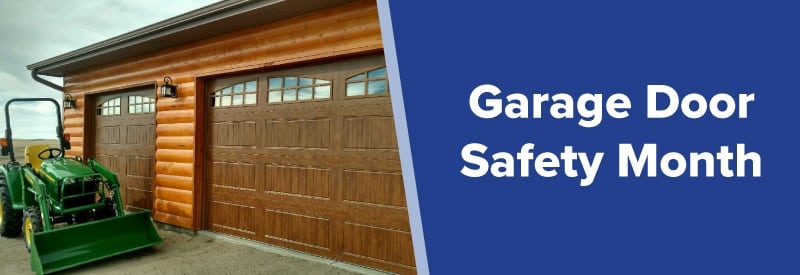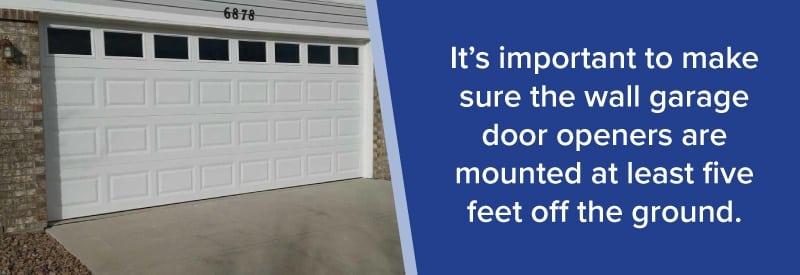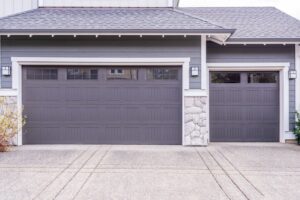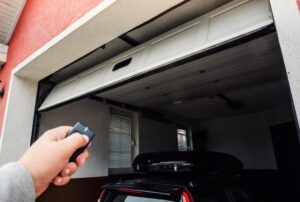
June is Garage Door Safety Month — an important reminder not to take garage door safety for granted; after all, this is likely the heaviest moving item in your home. Research shows we need the reminder as the majority of Americans have never had a professional perform a garage door or opener safety check. Without having these inspections, chances are you’re clueless about the condition of every one of the parts that make up your garage door system. As normal wear and tear occur, we’re leaving ourselves more susceptible to risk of garage door spring accidents and more.
Don’t wait until disaster strikes to fix a problem. Preventative maintenance goes a long way for home garage safety. After all, garage doors and openers aren’t cheap, and while accidents can leave doors and tracks bent, a financial hit isn’t even the worst-case scenario. The worst-case scenario is that in the midst of a garage door accident, a loved one is injured or killed — pinching, crushing and lacerations are among the most common injuries. Having a limb pinched between the rollers and tracks or panels of a door that weighs hundreds of pounds is nothing less than serious.
If you’re starting to feel motivated to be more proactive in your home garage safety, that’s great — but don’t let it go too far. Do-it-yourself garage door service repair is dangerous and leads to many of the injuries mentioned above. You can look for symptoms, but any hands-on work should be left to the professionals. They have detailed knowledge of how the parts of your garage door work together and know how to make adjustments or repairs safely.
Garage Door Tips for Safety
There are a lot of garage door safety tips, but we’ve narrowed it down to the top five we think are most important.

- Learn the different parts of your garage door system. It’s important to get to know your garage door opener, specifically the springs — without them, your garage door opener couldn’t function. Here are the basics of what you need to know about garage door spring safety. Two types of springs do the heavy lifting — the torsion springs, which are located horizontally above the top of the garage door, and the extension springs, which are attached to hooks and pulleys on either side of your garage door. If these springs are neglected over time, they can cause accidents that can hurt you and your bank account.
- Replace springs every six to eight years. To minimize the number of garage door spring accidents, replace them in a timely fashion. Both torsion and extension springs are under tension, making them extremely dangerous to fix. Normal wear and tear causes these springs to fail eventually. Rather than waiting for a snapped spring to cause damage to your door, valuables in your garage or members of your family, have a professional inspect your garage door opener every year and replace your springs every six to eight years, or as determined by a garage door professional.
- Familiarize yourself with your garage door’s emergency release feature. In the case of a power outage, your garage door opener is rendered completely useless. You need to know how to use the emergency release so you can open the door manually. Make sure you learn, using the owner’s manual, and practice so that you aren’t left in the dark about your garage door operation when you’re out of power.
- Consider replacing old openers with newer ones with safety sensors. Older models of garage door openers don’t have the same level of safety features built in as the newer models do. If you have an old model that doesn’t have sensors to trigger reverse motion, consider upgrading to a newer model.
- Have a professional inspect your garage door annually. The most important garage door safety tip is to make sure you have a garage door professional examine your opener once per year. While you may observe some signs of wear and tear, these professionals have the tools and expertise to dig a little deeper and make sure everything is working properly.
Garage Door Tips for Security
In addition to the garage door tips for safety, there are also additional measures you can take to maximize your garage door security. Below are some steps you can take to secure your garage from intruders and burglars. Some of these security options may vary depending on the age and type of garage door opener you have, but others are relevant regardless of the specific model.

- Add a timer to your garage door. The ultimate garage door security tip is to make sure the garage door is closed when it’s not in use. Having this large, heavy door completely closed gives you added security from intruders. Rather than relying on your memory to make sure you close the garage door every time you leave the house, consider adding a timer that automatically closes your garage door after a set amount of time, all the time.
- Unplug or lock your garage door while you’re on vacation. When you’re going to be away for an extended period, there are a few extra steps you can take to ensure intruders will not be able to open your door from the outside. If you have a newer garage door opener, consult the owner’s manual for a vacation mode, which disables the opener for a certain period. If that’s not an option, your door may have a manual lock on the inside of the door that you can fasten before you leave. If all else fails, simply unplugging the opener while you’re gone will also do the trick.
- Consider adding blinds or opaque film to windows. Garage windows are great for natural light, but whether you have them in your garage door, or on the outside of your home, the reality is they give people an easy view into your garage to see the car you drive and anything you store in that area. Keep the daylight, but stop putting your things on display by adding blinds or a film to all garage window glass.
- Purchase a garage door opener with rolling code technology. Have you ever worried about someone stealing the code to your garage door opener? If so, you can prevent code grabbing by purchasing a garage door opener that changes access codes every time you open and close the garage door. This is known as rolling code technology.
What Inspections Should Be Made Regularly

Two types of inspections should be made on a regular basis — a hands-on inspection by a garage door professional and visual inspections. You should schedule a hands-on inspection by a garage door professional once per year. This type of inspection gets under the surface to see how things are working, and if any of the parts need to be lubricated, repaired or replaced.
Visual inspections are informal inspections that you can do. Simply take a few minutes to look at a few different parts of your garage door and garage door opener to make sure everything looks good on the surface. These visual inspections should be done once per month and should solely be visual — if something looks out of place, call a professional.
If you’re doing a visual inspection, here are some of the things to check:
-
Springs
Garage door spring safety can make a big difference in preserving your garage door opener since springs play such a big part in making it work. These springs are specifically weighted to accommodate your garage door — not just any spring will do the job. Torsion springs may be inside of a tube for protection, which makes them impossible to inspect visually. But if your springs are exposed, here are some of the common signs of a damaged or broken garage door spring you can look for:
- Gaps in the torsion spring: If your spring is working properly, it should be seamless — meaning the torsion spring is wound up and in one solid line. If you see a gap, the spring has likely broken.
- Signs of rust: Left untreated, rust will destroy garage door springs, which leads to garage door spring accidents — for example, rust may cause a spring to separate from the hook and pulley system, rendering part of your garage door opener useless.
- Door shakes, vibrates or is crooked when opening or closing: If your door shakes, vibrates or is crooked when opening or closing, it may mean that one of your extension springs on the side of your garage door is damaged or broken. These springs work independently and so when one is damaged or broken, the other one struggles to pull the door up and down.
- Garage door goes up briefly and then stops: Some models may have a garage door spring safety mechanism in place that senses the weight is heavier due to a broken spring and stops the garage door from opening more than a few inches.
- Garage door goes down fast: Similarly, broken springs can also cause an open garage door to fall closed quickly as a result of being unable to properly balance the weight of the door evenly among the garage door opener springs.
- Cable and pulley are hanging: Depending on the structure of your specific garage door opener model, broken springs may lead to twisted and frayed cables. The easiest way to spot this is to look for any cables or pulleys that are hanging down off of their normal track.
-
DoorPanels
Take a look at your garage door and make sure there are no dents or bending of the door, specifically the top section. If your garage door has a broken spring, the force is redistributed, and it can cause pressure that bends the top section of your garage door.
-
Sensors
Checking the sensors is one aspect of your visual garage door inspection that will require a little more effort. The goal is to ensure that your garage door can sense something is in the way and reverse direction. To test this, push the button to close the garage door and then roll a ball through the door and observe the garage door’s reaction. If it doesn’t stop and begin to open back up, your sensors may be misaligned or completely out of order.
-
Reverse Mechanism
In addition to having sensors that trigger a reverse motion, garage doors should also have a mechanism in place to reverse motion if they hit something in their path. To test this, place a roll of paper towels in the door’s way and push the button to close the garage door. If the garage door reverses motion upon touching the roll of paper towels, you’re all set. If it continues in a downward motion, crushing the paper towel roll, it’s time to call a professional to inspect it.
-
Cables
There are cables located on the left and right of your garage door opener. Over time, these cables can get rusted or frayed and eventually break. Identifying signs of rust or fraying early can save you a lot of trouble in the long run.
-
Tracks and Rollers
The tracks and rollers on either side of your garage door are in plain sight and pretty easy to observe in motion. Do not attempt to make any adjustments to tracks and rollers, regardless of whether the garage door opener is stopped.
Childproofing Your Garage
It’s common to invest in child locks on cabinets and put gates throughout your house, but one room in the home that is often overlooked when it comes to child safety is the garage. Anytime your child is outside to play, and the garage door is open — or they are tall enough to open the door to the garage — they are at risk. Plus many of us use our garages as a place for storing a variety of things for cars, lawn and garden care, tools, trash and recycling and more.
Here are some ways you can childproof your garage to avoid accidents.

- Have a professional inspect your garage door annually. The first and most important step in childproofing your garage door is to make sure it’s working properly. A garage door that isn’t working correctly puts your child in danger in several ways. A broken garage door may fail to reverse if a child is in the way, randomly open and close, or send parts flying if a tension spring breaks or malfunctions. Minimize the risk of injury or death by having a professional inspect your garage door annually.
- Educate children. To children, the garage door may seem like a toy — being able to ride with it up and down or to race under the door while it’s moving to see if you can beat the door. It’s important to have a conversation with your children so they know the garage door is off limits and isn’t a toy. They should understand the danger that can come as a result of playing with the garage door.
- Consider pinch-proof panels. Just in case your children aren’t able to resist the temptation to play, replacing your garage door with one that features pinch-proof panels is a great way to childproof your garage.
- Mount your wall opener high. It’s important to make sure the wall garage door openers are mounted at least five feet off the ground. Mounting them at this height leaves the opener inaccessible to young children without the assistance of an adult and can make a big impact in minimizing risk.
- Store opener remotes out of reach. While some newer cars have garage door openers built in, many people still have garage door opener remotes. Keep these remotes in a cabinet or drawer with a child lock, or somewhere else that children aren’t able to reach them.
- Keep car doors locked. There are two main reasons to keep your car doors locked for the benefit of children — it eliminates any risk of injury that comes with opening and closing car doors, and it’s another step toward keeping garage door opener remotes out of reach. Get in the habit of locking your car doors on your way into the house to help keep children safe.
- Store toys elsewhere. One of the reasons many children wander into the garage is to retrieve bikes, scooters, skateboards and other outdoor toys that are stored in this area. To minimize the amount of time children spend in the garage — and the motivation for them to go into the garage — consider storing these larger toys in the basement or a shed.
- Store hazardous substances and tools out of reach. Believe it or not, the garage can become a dangerous place for children due to several common hazardous materials and tools. Chances are you have one or more of the following in your garage: antifreeze, windshield wiper fluid, gasoline, oil, fertilizers, pesticides, charcoal, cleaners, paints, lighter fluid, lawn and gardening tools or industrial tools. Make sure you take an audit of the substances and tools you store in your garage and either lock them up or put them out of reach.
Celebrate Garage Door Safety Month All Year Long
At American Overhead Door, we encourage you to celebrate Garage Door Safety Month all year long by observing these garage door safety tips. If you need to have a garage door professional come to inspect your door or to help you resolve a problem, we are here to help. We’re a local company that has won the Better Business Bureau’s Customer Service Award two years in a row, so you can be confident you’re getting reliable, trustworthy service. To get started, all you have to do is contact us. You can also get in touch with us by calling us at at 719-538-9900 or 719-530-3000 for our Salida location.




